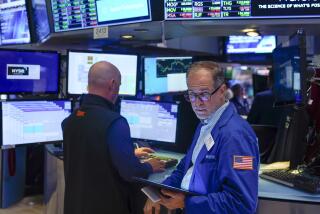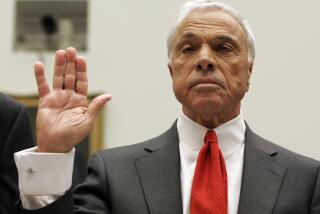The Risk in Hiding Behind a Hedge
- Share via
In the TV reality show “The Biggest Loser,” overweight contestants get serious about trimming down and getting healthy. The fun for viewers is in trying to pick the ultimate loser/winner.
Wall Street lately has been focused on its own version of “The Biggest Loser.” This game entails trying to guess which hedge fund has made enough bad trading bets to wipe itself out and cause a domino effect -- perhaps toppling a major bank or brokerage.
Fear of a large-scale financial failure loomed over markets last week, helping to send stocks lower and drive more investors into the perceived safety of Treasury bonds.
It has become convenient in recent years to blame hedge funds for every market hiccup or anomaly. And why not: There are about 8,000 of these funds out there, and they exist to exploit investment opportunities in any and all securities. They can move fast, and they often use leverage, or borrowing, to get more bang for their bucks.
What also makes them easy to blame is that they are mostly secretive about their trading, and they’re largely unregulated. If something is awry in markets, Wall Street figures hedge funds must be at least partly responsible.
Worries about excessive risk taking at the funds have been background noise in the markets since June, when the Federal Reserve began raising short-term interest rates. Bad things have been known to happen to highly leveraged investors when the central bank is tightening credit.
Concerns about a blowup came to a head May 5, when credit rating firm Standard & Poor’s downgraded General Motors Corp.’s debt to junk, citing concerns about the automaker’s eroding earnings outlook. The story on Wall Street trading desks was that some hedge funds were big holders of GM bonds, or dealt in so-called derivative securities tied to those bonds, and so were slammed as the debt tumbled in value.
Since then, markets have grown more skittish about hedge funds’ participation in all sorts of transactions that may have looked like winners a year ago but that now seem illadvised.
The funds have long been active players in the market for credit derivatives. These are contracts by which investors trade risk with each other. For example, credit default swaps allow investors to buy or sell insurance against the chance of a company’s defaulting on its bonds.
Swaps have become a big business: The notional value of default swaps outstanding was $8.4 trillion at year’s end, up from $631 billion in mid-2001, according to the International Swaps and Derivatives Assn.
Notional value is the hypothetical underlying sum on which a swap’s payment obligations are computed. It doesn’t mean that’s what the players are on the hook for. Nonetheless, the growth of swaps tells us that a lot of risk trading has been going on via the derivatives market.
On its face, risk trading isn’t a bad thing, of course. It allows some investors to lower the risk in their portfolios while allowing others to take on more risk when they believe that the returns justify it. Fed Chairman Alan Greenspan in the past has lauded derivatives for making the global financial system more sound, not less so, by spreading risk more broadly (as opposed to keeping it concentrated in, say, major banks).
But on both sides of a derivatives transaction, the investors are making certain assumptions about the best- and worst-case scenarios for the economy, interest rates and other factors that affect the transaction.
That’s where trouble can arise: If investors’ worst-case scenario underestimates what actually could (or does) go wrong, the transaction can be a bomb for one or both players.
Then the problem becomes who owes whom -- and if one party can’t pay, does that create a chain reaction of missed payments that snakes through the financial system?
This risk isn’t mere science fiction. In September 1998, turmoil in global financial markets left the giant hedge fund Long-Term Capital Management on the brink of failure. The assumptions it had made in its complex derivative trades proved grossly inaccurate.
As the fund’s losses mounted, regulators including the Fed saw that the portfolio’s heavy use of leverage from banks and brokerages meant that its failure could cause a domino effect across Wall Street. Under the Fed’s aegis, Long-Term Capital Management’s creditors engineered a bailout that gradually unwound the portfolio, averting a financial crisis.
In a speech May 5 -- the same day of the downgrade of GM’s debt -- Greenspan talked at length about derivatives, financial risk and the lessons from Long-Term Capital Management.
His conclusion was that regulators, banks and brokerages learned plenty from that near-failure, and that they have a better handle today on the risks inherent in derivatives and on hedge funds’ involvement in those transactions.
But Greenspan also acknowledged that the sheer growth in the variety of derivatives since 1998 meant that the financial markets were, to some extent, in uncharted territory.
“The rapid proliferation of derivatives products inevitably means that some will not have been adequately tested by market stress,” he said.
David Brownlee, a bond fund manager at NL Capital Management in Montpelier, Vt., put it more colloquially. “I’ve been managing bond money for 26 years, and I don’t understand a lot of these [new] derivatives,” he said.
Hence, the possibility of a derivatives meltdown induced by hedge fund failures no longer seems as farfetched as it might have seemed a few months ago -- particularly because markets have become so disjointed in recent weeks, wreaking havoc with many big investors’ assumptions.
Last week, for example, the price of oil plunged 6.5% from Monday’s closing level through Friday. An investor might naturally assume that would be good for the stock market. Instead, the Dow Jones industrial average slumped 2.4% in the same period, ending the week at 10,140.12.
Nervous over GM’s outlook and other issues, investors continued to push up yields on junk bonds last week. The average yield on 100 junk issues tracked by KDP Investment Advisors ended the week at 7.81%, up from 7.62% on Monday and the highest since June.
By contrast, the yield on the 10-year Treasury note slid to 4.12% by Friday from 4.28% on Monday.
These may look like small shifts. But for hedge funds and other traders that make money by betting that market moves will be correlated in predictable ways, even mildly disjointed markets can be a nightmare.
They also can present opportunities. Bill Gross, the Newport Beach bond market guru who manages the Pimco Total Return bond fund, said late last week that he had been buying some of the shorter-term bonds of Ford Motor Credit Co., the financing arm of the automaker, which S&P; also downgraded to junk on May 5.
With yields north of 7.5% on bonds maturing in two years or less, Gross said he considered the return to be worth the risk.
“We’ve started to dip in,” he said.
At the same time, Gross said, there’s ample reason to be concerned that other shocks loom in the financial system, as tighter credit exposes ill-conceived investment bets.
“I think there’s more unwinding to go,” he said.
*
Tom Petruno can be reached at [email protected].
More to Read
Inside the business of entertainment
The Wide Shot brings you news, analysis and insights on everything from streaming wars to production — and what it all means for the future.
You may occasionally receive promotional content from the Los Angeles Times.










